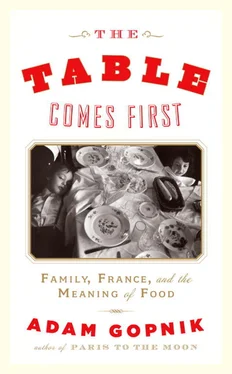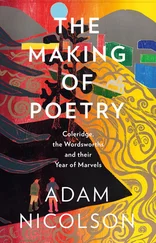Oh. Rather like… rather like minstrel music? I hear you ask. Well, yes and no, I reply—yes, in that they’re imitating the sound, no, because it’s serious and sexual and admiring. Anyway, I keep an electric guitar tuned to an “open G,” Keith’s favorite, and strum through it, searching for those voicings, the dumb revelation that most of what seems mysterious and beautiful—from Stones riffs to béarnaise sauce—is just a matter of breaking it down and learning the technique. The tuning matters even more than the technique, and I wonder if that isn’t true of cooking as well. The tuning is just the base of what you do—the eggs you buy, the fishmonger, the thing itself—and with every good cook I’ve known, the sound is like that: a good tuning and a resonant drone, a fine fish and a favorite spice.
In any case, I thought to myself, well, Keith Richards, there’s the man, be more like him; utterly forgiven, no matter what he says or does—women are all bitches, and gay people are poofters, and no one is indignant or offended, because we all make up the rules by which we are to be judged in advance. Declare yourself irresponsible when you begin to act, and all will be forgiven when you are. In this case, the book, crafted as a celebration of living on the edge, is in fact on every page a testimonial to the privileges of money and fame. Each time poor Keith is about to be arrested for drug possession (of which he is, like it or not, always guilty), he is saved by a lawyer or hyperwealthy fan (or the father of a groupie) who intervenes on his behalf. … Well, okay. He’s still a wonderful guitarist. (The funniest and most telling remark in the book concerns his bandmate Ronnie Wood. After detailing Wood’s many long periods of crack addiction, and his many efforts in rehab to get free from them, Keith concludes, “To be honest, it didn’t make much difference. He was about the same both ways.” Thus the epitaph on all artistic addictions.)
But after all the heroin and the cocaine and the general sense of a man nodding off in space, what really gets Keith alight, what does he end up caring about most? Yes, he devotes a few glancing evocative paragraphs to guitar playing, the technique of the blues, a few words to warn against freebasing. But what is the one thing that he offers in carefully itemized detail? The one thing that he offers with real zing and passion? His recipes!
His favorite food! His own ways of making shepherd’s pie and bangers and mash—which he reproduces right there in the book alongside his tales of scoring heroin on the Riviera. How you should get bangers made fresh—presumably a challenge in Connecticut, where he lives, though God knows there’s probably a chic pork store in Greenwich by now—and then, interesting point, this, that you should put the sausages cold into the frying pan, and then slowly turn up the heat. Rather an English approach, but still, okay, and there’s something nice about the way he implies his mashed potatoes but doesn’t feel it necessary to explain his mashed potatoes. His shepherd’s pie, ground meat and more of those mashed potatoes, sounds very good—and, as a true food lover will, he insists that the key moment is the moment when you plunge the knife into the shepherd’s pie. The aroma, not the dish, fulfills the appetite. So the attempt to run away from food to something more obviously male , rock and roll, leads us inevitably and inescapably … back to food. If Keith writes down recipes for his readers, we can all write down recipes. And with it share the strong, intelligent realization that it is the first cut of the shepherd’s pie that makes the pie—that is the point of the pie.
And then—there is a connection here, trust me—the point that Keith makes about his distinctive open-G tuning is that it’s a drone tuning, a folk tuning—that one steady note, the G, buzzing in the background even as the rest of the chords mark the changes. (And he makes the musically alert point that Vivaldi and Mozart write this way, too, in reverse, with the steady unchanging note up in the treble.) Would you agree with me that the folk tuning of food, the open-G tuning, is rice pudding? Everywhere you go in the food world, there is a rice pudding playing somewhere in the background, droning a little sweet and nubbly number behind everything more ambitious that goes on. If you go out for Indian food, you can rely on a rice pudding; if you go for Italian, or Greek, there is at least a pudding made with rice. In every culture and every country, as Elisabeth Luard’s lovely book Sacred Food demonstrates, some mix of rice and milk (or coconut milk) and vanilla (or cardamom) and sugar (or honey) is the drone sound of the table. And this sweet, this pudding, is almost always part of rites of passage, of weddings and christenings and funerals, gifts to the gods and rites of the elders. There seems to be something close to a natural magnetism between rice and ritual, most familiar to us in the habit of throwing rice at weddings (and leading to Woody Allen’s perfect one-liner about the wedding where the bride was pregnant and everyone threw puffed rice). And what’s more, just as Keith says about open-G tuning—that it lets you add stray extra notes to the chords, so that in every G there’s a touch of A; in every B dominant seventh, a little hint of E minor—is true of pudding-making, too. A certain sloppy elegance is necessary in both rock guitar and rice desserts.
I make three rice puddings, and each one has a savor and meaning particular to itself. The first and in some ways the simplest, and in some ways my favorite, is the baked-custard rice pudding my mother used to make. I’m not sure where she learned it—and I know that I could answer that question with a phone call, but somehow making that phone call turns recollection into an interview—but it’s simple and perfect. You take two cups of cooked rice, left over from the night before, most often (and I often don’t oversalt the rice so that it works for the next-day pudding), put it in an ovenproof dish, and then make a simple custard alongside—say, six cups of milk, five eggs, two-thirds of a cup of sugar—which you beat together and heat until it’s almost scalded but not yet thickened. Then you just pour it over the rice, add some black raisins, and bake for about an hour at around 350°. Oh, and sprinkle some cinnamon on top when you put it in. You take it out when a knife comes out almost dry. (Almost dry—it’s one of those cooking terms, like “about to boil,” that are unknowable regions that everyone is thought to know.) The thing that I think is nicest about this pudding is what the kids don’t like: the rice and raisins settle down sweetly on the bottom of the pudding cup, while the rich but simple custard sits on top. It’s really a two-layer pudding, a sort of wholesome pousse-café . I love this effect, but it is, I will admit, antipudding in conception, since a platonic pudding is one in which everything is evenly mixed. For children, the promise of a pudding is that there will be no unpleasant surprises.
So the second pudding I make, most often with Olivia, is one that solves this problem by mixing things all together and smooth. I add Indian spices, too. You just make your rice on the stovetop with coconut milk instead of water, and then you make a simple crème anglaise, a stovetop custard: six egg yolks, four cups of milk, into which you place four to eight crushed cardamom pods. You mix the coconut rice into the cardamom custard, sprinkle on cinnamon, and let it cool.
My trouble with this one is that whenever I make a crème anglaise it never gets quite custardy enough. My friend Peter Hoffman suggested working with a candy thermometer, so that I’ll know when it’s at 165°. That helps, though not always and not enough. The curdles come. So I add to the custard… a bit of liquefied cornstarch. That always works. Cornstarch and gelatin, the two thickeners of an earlier age, have more going for them than we quite allow. Cornstarch is also, along with Karo syrup and condensed milk, one of the three bashful but beautiful sweet ingredients. What can improve on a pecan pie made with Karo dark syrup, or on a chocolate fudge sauce made with its lighter brother? And is there anything better than a key lime pie made with condensed milk and a graham-cracker crust? And a butterscotch pudding made with cornstarch and burnt brown sugar has a depth of flavor that few Sauternes can equal. Sweet is simple, emotionally and practically.
Читать дальше












